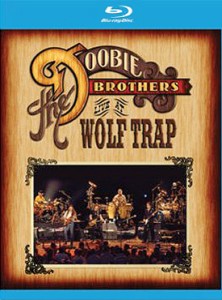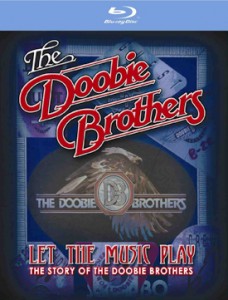The Doobie Brothers: Live at Wolf Trap
Blu-ray (also available on DVD, CD, and vinyl)
Eagle Vision
Total Running Time: 166 minutes (including extras)
Our Rating: 4 out of 5 stars
From the opening motorcycle revving to the closing bows, “The Doobie Brothers: Live at Wolf Trap” makes a solid two-hour case for why the Doobies stand shoulder-to-shoulder with the greatest bands of the classic rock era. The two-hour show is packed with iconic hits that never seem dated: “Long Train’ Runnin’”, “Take Me In Your Arms”, “Jesus is Just Alright”, “Black Water” – the list goes on and on. Filmed in 2004 at Virginia’s Wolf Trap National Park for the Performing Arts, the band immediately launches into a groove that combines elements of rock, country, bluegrass, blues in a way that is always appealing and flat-out fun. And, as the closing credits roll, one question is clear: Why aren’t the Doobie Brothers in the Rock and Roll Hall of Fame? They’re looooong overdue.
The 2004 Tommy Johnston-led line-up draws almost exclusively from the band’s LPs from the 70’s that featured Johnston on lead vocals and guitar. Songs from the considerably mellower Michael McDonald era of the 1980’s are almost entirely absent – a respectable move given that McDonald’s “ya mo’ be there” vocal is such an inseparable earworm trademark. The sole McDonald track performed at the Wolf Trap – “Takin’ It to the Streets” – is handled vocally by founding Doobie, Pat Simmons, and the Brothers’ touring bassist, Skylark. The result is a live version that is equally as good if not better than the original version. It also provides the energetic bassist some center stage time that he so richly deserves. In fact, if there’s an intoxicatingly awesome performance to watch on this disc, it’s his.
Despite the fact that the concert is from almost a decade ago and has been available on DVD for nearly as long, it truly shines on this first-ever Blu-ray issue given that the show was filmed using 10 high-definition cameras. While the overall program does suffer some from rapid-fire editing, the picture is always crisp and clean and the colors are perfectly balanced. The disc defaults to a LPCM stereo audio track that often buries the lead vocals so much that they’re almost inaudible in various spots. Switching over to the vastly superior DTS Master HD mix provides a much more even mix that utilizes the surround channels very effectively.
The disc also suffers from other technical issues that should have been corrected before this disc made it to market. The biggest problem is the extreme difference in sound levels between the live concert itself and the bonus features that are included, which include “backstage pass interviews” (which is more-or-less a sampler from the “Listen to the Music” documentary released late last year) and interactive links that appear during the concert that allow the viewer to jump into interview segments that directly pertain to the song being performed. While this audio glitch isn’t a big deal for the former, it’s hugely frustrating to have to crank up the volume to hear what Johnston and Simmons are saying and then, as a result, return to the concert footage now at deafeningly-loud sound levels. Some simple equalization and basic mixing would have gone a long way. It’s also somewhat annoying that the distracting talking head icons that appear at the bottom left corner of the screen to indicate the availability of the in-concert interview clips can’t be turned off completely.
Technical issues aside (they’re the only reason I’m docking this one by a full star), this is an amazing disc that showcases a legendary band in peak form. Now 40+ years on down the track, the Doobie Brothers’ long train is still runnin’ as strong and as powerful as ever.



